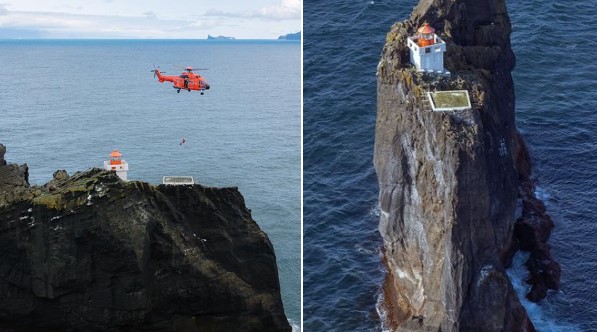Thridrangar Lighthouse (Þrídrangaviti Lighthouse) is known as the most isolated lighthouse in the world. Perhaps a lot of people are drawn to remote locations all over the world. When you first see the Þrídrangaviti lighthouse, it appears as though it belongs in a storybook: three cliffs near Vestmannaeyjar (Westman Islands) with a stunning white cottage and a red beacon. It is an operating lighthouse located in the Vestmannaeyjar archipelago, 7.2 kilometers (4.5 miles) off the southwest coast of Iceland.
It was constructed between 1938 and 1939, and it stood atop a rocky cliff that was exceedingly steep and perilous. On July 5, 1942, the lighthouse was placed into service. Reaching the Thridrangar Lighthouse required climbing the highest of the three granite towers. Built entirely by hand without the aid of technology, it is a remarkable feat of human endurance and ingenuity. The lighthouse gained popularity in 2009, when it became internationally known when Árni Saeberg’s photo appeared in MorgunblaŰië.
Nevertheless, there is no proof that anyone has ever lived there; despite its breathtaking view, the Thridrangar Lighthouse has been declared uninhabitable for a long time. The Thridrangar Lighthouse is a well-liked destination for tourists interested in Iceland’s natural beauty and maritime history because of the area’s well-known dramatic and stunning scenery. The name Þrídrangar, which translates to “three rock pillars,” alludes to the three sea stacks at that place: Þúfudrangur, Klofadrangur, and Stóridrangur, the lighthouse’s location.
Under Árni Þórarinsson’s direction, the construction crew climbed the sea stack in three pitches, living in tents on the rock for a month while their climbing gear prevented them from biting into the rock near the top. Without any handholds, they had to construct a three-person human stack for the last pitch.
The lighthouse is a technical marvel as well as a beacon of light. It is located approximately 30 meters above sea level and is a 4 x 4-meter building material-whitewashed single-story hut with a roof shaped like a battlement on a fortified castle tower, complete with embrasure-like openings. The red lantern is 4 meters high and rests on the roof. The light is 34 meters above sea level, which refers to the “height of sight,” which states that the light beam is first discernible at sea level from 16.7 kilometers away.
These days, you can only reach the lighthouse by helicopter. Although it is closed to tourists, there are plenty of other Icelandic helicopter excursions that take you to hotspots where you can see the northern lights, Reykjanes craters, and active volcanoes. On July 5, 2020—the 78th anniversary of the light—the Icelandic band KALEO released a music video shot on the helipad. This was shortly after the start of COVID-19, at a time when people were isolating themselves and distant habitations were at their height.
Therefore, taking helicopter tours to active volcanoes, Reykjanes craters, and Northern Lights hotspots offers a unique and breathtaking way to witness the natural beauty of the country. Helicopter tours sound like an amazing way to explore Iceland’s scenic wonders. As stated by Þórarinsson: he enlisted seasoned climbers to ascend the sea stack.
“First, we had to build a road up to the cliff. We then assembled a group of skilled mountaineers from the Westman Islands, and we brought drills, hammers, chains, and clamps to fasten the chains. When they got close to the top, there was nowhere for them to get a grip on the rock, so one of them got down on his knees, the other two stood on his back, and the third climbed on top of the other two to reach the edge of the cliff above. I cannot even begin to imagine how I felt watching this extremely risky process.”
The adjacent Westman Islands offer a plethora of activities, despite the fact that this lighthouse is inaccessible to the general public. The largest island, Heimaey, has a population of 4,300, while the remaining 15 islands in the archipelago are uninhabited. The islands are teeming with seabirds, particularly seals, whales, and puffins, and are home to two volcanoes, one of which erupted in 1973 and forced islanders to evacuate. Furthermore, an underground eruption between 1963 and 1967 created the island of Surtsey, which is remarkable because it has remained uninhabited and unaltered by humans since its creation. Read More: Nugget Point Lighthouse











